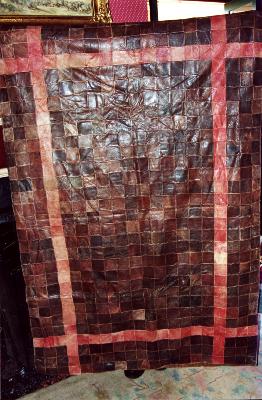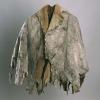Quilt No.528DT - Di Tement

Owner:
Di Tement
Location:
TAS Hobart
Maker
Maker:
Unknown
Made in
Unknown
Date:
1881 - 1900
Description:
Leather buggy rug constructed from hundreds of squares each 60mm. There is a pink band of the same size squares 3 rows in from each border. There is no padding. The backing is a towelling type material.
1140 x 1700mm
History:
This buggy rug is part of the 'Adam Tement Collection'. Adam Tement 1962-1990 lived in Launceston and was a serious collector of Australian pottery of which he had a very fine national collection. He later "fell in love with quilts" [Di Tement]. Adam died of cystic fibrosis and the quilts are now owned by his mother Di.
Related Quilts:
Kangaroo skin cloak of seven gores is made from the skins of seven grey kangaroos (Macropus fuliginosus). The skins vary in size and shape, the inner five are roughly triangular. The cloak is edged with a series of loops, through one of these near the collar is a piece of cloth which appears to have tied the cloak together. The skins are sewn together with two sorts of linen or cotton thread. In a small diamond-shaped gusset at the back of the neck there are some stitches of sinew. The skins are sewn together by means of a small hem which was turned back on to the fur, so stitches went through two layers of skin on each gore. There are some small holes in the skins. The skins are very soft and pliable, and greyish in colour; they vary in size and shape.
Longest part: 800mm
Ref: MA Thesis 1973, S.Meagher 'A Reconstruction of the Traditional Life of the Aborigines of the S.W. of Western Australia.
"This is a coverlet of pale blue cotton muslin, highly decorated with appliquéd pieced bands, figures, and embroidery. The edge of the quilt is finished with bands of yellow, white and green cotton attached with ladder stitch.
Down the centre field of the design and 4 poems embroidered in quite crude chain stitch. Each piece of prose is accompanied by an appliquéd illustration. For example a large clock accompanies a poem of time. 'While shepherds watch their flocks at night�.'is illustrated with a beautiful scene of the manger watched by an angel, cows and sheep. The appliqué and embroidery is executed crudely with large stitches in running and overcasting. The quilt is signed, 'M.J.H. aged 84 yrs.1924.' " [NGA] There is no padding or lining. 1640 x 1540mm
Down the centre field of the design and 4 poems embroidered in quite crude chain stitch. Each piece of prose is accompanied by an appliquéd illustration. For example a large clock accompanies a poem of time. 'While shepherds watch their flocks at night�.'is illustrated with a beautiful scene of the manger watched by an angel, cows and sheep. The appliqué and embroidery is executed crudely with large stitches in running and overcasting. The quilt is signed, 'M.J.H. aged 84 yrs.1924.' " [NGA] There is no padding or lining. 1640 x 1540mm
Rug made from 40 brown fur skins (8 rows by 5), possibly possum. Skins are sewn by machine, with seams covered with white tape. Rug is backed with cream wool felt, and bordered with beige scalloped felt. There is a braid binding along the outer edge of the skins. No padding.
1640 x 1480mm
Pieced hexagons, English paper method. Large hexagons form the centre with a border of smaller hexagons. The fabrics are all cotton in a wide range of colours and patterns. There is no padding. The backing is cotton, large white floral design on dark blue. The hexagons are hand pieced and the edges machined.
2480 x 1420 mm
2480 x 1420 mm
Cotton frame quilt with a diamond in the centre of the frame and a border of straight pieces. The outer border is diamonds. The quilt is hand sewn and hand quilted.
1910 x 1830mm
1910 x 1830mm
Randomly patched quilt in many different colours and fabrics. There are appliquéd shapes over many pieces including Suffolk Puffs, hearts, hexagons and other shapes. There is an embroidered inscription "A11 to S11 1829" which is thought to mean AN to SN 1829. There is no padding and the backing is white cotton.
2000 x 2200mm
2000 x 2200mm






